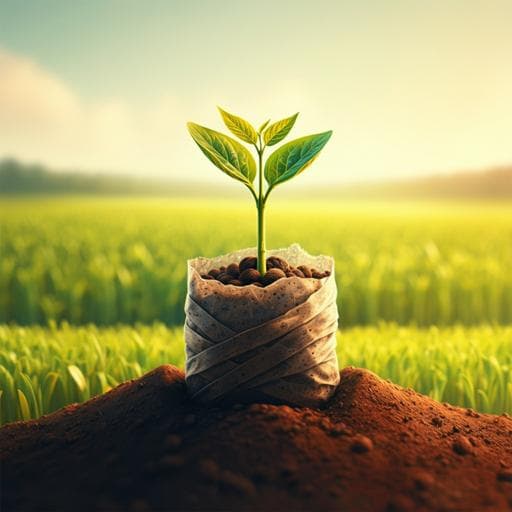
Agriculture
Plant-biomass-based hybrid seed wraps mitigate yield and post-harvest losses among smallholder farmers in sub-Saharan Africa
T. Pirzada, A. Affokpon, et al.
This innovative research introduces a 'wrap and plant' seed treatment platform utilizing biodegradable wraps from banana waste to combat soil-borne pathogens. Conducted by a team of experts, field trials in Benin showcased its potential in controlling yam nematodes, boosting yields, and minimizing post-harvest losses, paving the way for improved food security in sub-Saharan Africa.
~3 min • Beginner • English
Introduction
Sub-Saharan Africa faces rapid population growth and lagging agricultural productivity due to climate change, poor soils, continuous cultivation, pathogen pressure and resource limitations among smallholder farmers. Yam is a critical staple and cash crop in West Africa, yet 17–50% of annual production is lost to plant-parasitic nematodes (PPNs), particularly the yam nematode Scutellonema bradys. Because S. bradys is frequently disseminated with infested seed pieces and continues to reproduce during storage, early-season control at planting is crucial for yield and to reduce post-harvest losses. Seed treatments can deliver nematicides at reduced doses directly to the root zone, limiting non-target exposure. Building on prior work showing banana-fiber-derived paper as a controlled-delivery matrix, this study proposes and evaluates a biodegradable, plant-biomass-based 'wrap and plant' (W&P) seed wrap—engineered from banana fiber and recycled cardboard—to deliver ultra-low-dose abamectin and mitigate nematode-induced yield and storage losses for smallholder yam producers in Benin.
Literature Review
The study situates the problem within extensive literature on PPNs (Meloidogyne spp., Scutellonema bradys, Pratylenchus spp.) as primary constraints to yam production and quality in West Africa, noting limited affordable control options. It references the widespread presence and importance of S. bradys and its contribution to post-harvest losses and seed-piece infestation. Prior research on banana fiber indicates advantageous porosity, morphology, and cost-effectiveness for controlled delivery matrices. Recycled old corrugated cardboard (OCC) is discussed as a strengthening component with layered morphology that can tune mechanical properties and release profiles. Literature on paper/fiber properties (burst strength, porosity, lignin/cellulose interactions), soil biodegradation of lignocellulosics, abamectin photolysis, and bioassay methods underpins the material selection and evaluation approach.
Methodology
Materials and matrix fabrication: Banana (Musa acuminata) fiber (BF) and recycled old corrugated cardboard (OCC) fibers were pulped via a chemical-free process and formed into handsheets of varying BF:OCC ratios (BF only; BO82 80:20; BO64 60:40; BO46 40:60; BO28 20:80; OCC only). Physical characterization included SEM of surface and cross-sections, FTIR, burst index, density, air resistance (porosity proxy), and thermogravimetric analysis (free vs bound water). Soil integrity and biodegradability were assessed by incubating samples in soil with tomato plants for up to 21–28 days, followed by mechanical testing (stress–strain; Young’s modulus) and SEM imaging. Water sorption and flow were quantified to relate porosity to diffusant transport.
Active ingredient loading and interactions: Abamectin (Abm) was applied as an ultra-low dose to matrices. Weakly vs strongly bound Abm fractions were quantified by sequential DI water sonication (5 min) and acetone extraction, analyzed by HPLC. Isothermal titration calorimetry (ITC) probed Abm interactions with BF, OCC, lignin and cellulose to infer binding energetics and sites. UV stability of Abm on matrices was assessed under UV exposure up to 180 minutes, with recovery by acetone and HPLC quantification. Bioactivity retention after soil burial was evaluated using Caenorhabditis elegans bioassays, comparing BP (pilot-scale banana paper), BF, OCC, and BO82 across burial times and hydration cycles.
Pilot-scale production: Based on balance of biodegradability, strength, water sorption and release, an 80:20 BF:OCC composition (BO82) was selected and scaled to 25.4–30.48 cm-wide rolls (BP) on a Fourdrinier machine (target grammage 70–80 g m−2). BP morphology was validated via X-ray microtomography and SEM; mechanical properties were benchmarked pre- and post-soil incubation.
Field trials (Benin, 2015–2018): On-farm trials were conducted in three districts—Glazoué, Savè, and Savalou—within the Guinea–Sudan transition zone. Design: randomized complete block with five replicates and three treatments per plot: (1) BP with abamectin (BP-Abm; each 15.25 × 20.25 cm wrap contained 10 µg Abm; field rate ≈ 1.0 g ha−1), (2) BP only, and (3) farmers’ practice (FP; untreated). Each plot: four rows × six mounds; one seed yam per mound (cv. Klatchi of D. cayenensis–rotundata), wrapped per treatment. Pre-plant soil nematode densities were assessed by composite cores and centrifugation extraction. Planting occurred at rainy-season onset each year; no fertilizers or other pesticides were applied; cultural practices followed local norms. Harvest was 7–8 months after planting.
Yield and storage assessments: Yields were recorded as t ha−1. Post-harvest storability (2016–2018): two tubers per plot were stored for 3 and 5 months in an open-sided yam barn; tuber weight loss was calculated; tuber health (dry rot and cracking) scored; nematode population density (S. bradys per g peel) measured at harvest and after storage; reproduction factor (Rf) computed. Statistical analyses used one-way ANOVA and combined factorial models (PROC GLM, SAS), with Waller–Duncan k-ratio t-test for mean separation. Rainfall data were recorded to contextualize seasonal effects.
Key Findings
- Material properties and release: Increasing BF content increased porosity and water sorption/flow; BF and BO82 showed faster water uptake and more hard-to-remove (bound) water, favoring diffusion and gradual release. OCC increased strength and Abm binding. ITC showed exothermic interactions: stronger binding with OCC and lignin than cellulose; BF exhibited multistep binding, indicating heterogeneous sites. BP (80:20 BF:OCC) retained Abm bioactivity in soil longest among tested matrices (approximate bioactivity retention: BF 10.3 d, BO82 14.3 d, OCC 20.7 d, BP 25.0 d).
- Field yields: Across on-farm trials, W&P treatments increased yam yields compared to FP (P ≤ 0.01). 2015: BP-Abm increased yield by 28–57% and BP by 27–53% over FP. 2017–2018 Savalou trials: 9–22% (2017) and 16–40% (2018) increases versus FP. Overall, BP-Abm mean yields rose from 13.2 t ha−1 (2015) to 15.2 t ha−1 (2018).
- Nematode suppression: At harvest, BP-Abm substantially reduced S. bradys populations in tuber peels versus FP and BP, with up to ~80% reduction relative to FP. Treatment differences persisted after 3 and 5 months’ storage; FP had the highest S. bradys densities and reproduction factors, BP intermediate, BP-Abm lowest (P ≤ 0.01).
- Post-harvest quality: BP-Abm and BP improved tuber storability. Tuber weight at harvest was higher with W&P (P ≤ 0.01). After 3 months’ storage, FP tubers lost a greater percent of weight than BP-Abm; BP was intermediate (lsd = 0.81, α = 0.01). After 5 months, S. bradys populations multiplied 2.5–3× in FP vs 1.5–2× in BP/BP-Abm; W&P treatments reduced dry rot and cracking across regions and timepoints.
- Rainfall effect: Larger treatment benefits occurred in drier seasons; heavy rainfall and flooding (notably 2016–2017) reduced differences, likely due to alleviation of water stress and dilution of the microdose Abm.
- Economics and perception: Cost–profit ratio improved from 59.93% (FP) to 79.3% (BP-Abm). Net margin: BP-Abm 1,112,080 FCFA ha−1; BP 768,515 FCFA ha−1; FP 723,498 FCFA ha−1. Stakeholders (farmers, processors, traders) preferred W&P-treated tubers due to better quality and organoleptic properties; BP-Abm often most favored.
Discussion
The W&P platform addresses the key constraint of early-season S. bradys infection by delivering an ultra-low microdose of abamectin directly at the yam seed piece, improving early protection while minimizing environmental exposure. The hybrid matrix balances BF-driven porosity and diffusion with OCC-conferred strength and binding, enabling controlled release and adequate root penetration, then biodegrading in soil. Field results across diverse locations and seasons demonstrate consistent yield gains and significant reductions in nematode populations, translating into improved post-harvest storability (lower weight loss, less dry rot/cracking). Seasonal rainfall modulated the magnitude of benefits, consistent with physiological compensation under high moisture and potential dilution of microdose Abm. Notably, BP alone (no Abm) frequently outperformed FP, suggesting additional mechanisms such as physical/chemical interference with host–nematode signaling and microenvironmental effects of the wrap. The platform’s solid-phase, equipment-free application lowers barriers for smallholders and reduces active ingredient usage, supporting sustainability and food security goals.
Conclusion
This study demonstrates a biodegradable, plant-biomass-based seed wrap (80:20 banana fiber:recycled cardboard) as an effective, scalable platform for delivering ultra-low-dose abamectin to control yam nematodes in smallholder systems. Across multi-year, multi-site trials in Benin, W&P increased yields, suppressed S. bradys populations at harvest and during storage, and reduced post-harvest weight loss and physical defects, with strong farmer and consumer acceptance and improved profitability. The wraps exhibit tunable strength and release profiles, soil integrity sufficient for early growth, and enhanced protection of Abm against photolysis. Future work should optimize cost-effective commercialization pathways, adapt the platform into diverse formats (pouches, slips, trays), and expand to delivery of other actives (nutrients, biologicals, insecticides, fungicides) and to additional crops and pathogens.
Limitations
- Seasonal dependence: Heavy rainfall and flooding reduced observed yield differences, likely due to water-stress compensation and dilution of the microdose abamectin, indicating performance variability under very wet conditions.
- Geographic scope: Field trials were limited to three districts in Benin; broader agroecological validation is needed for generalization.
- Economic/scale-up: The cost of commercializing and distributing W&P at scale remains to be determined, including supply chains for biomass and manufacturing.
- Treatment differentiation: In some trials, differences between BP-Abm and BP were small, suggesting context-dependent incremental benefit of Abm beyond the wrap alone.
Related Publications
Explore these studies to deepen your understanding of the subject.







